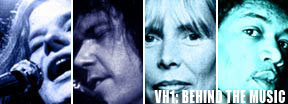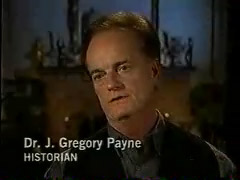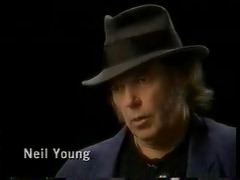VH1 Behind the Music: 1970
The year the Vietnam War came home.

VH1 (1:00) Behind the Music 1970 offers an intimate look into the personal lives of musical artists as well as the provocative and often controversial issues and trends shaping the world of music. 1970 was the year the Vietnam war came home and peaceful ideals of the '60s gave way to horror. Anti-war activists protesting the invasion of Cambodia found themselves being gunned down for their beliefs. CSNY (Crosby, Stills, Nash & Young) memorialized the Kent State tragedy in the song "Ohio."
Guests include: Dr. J. Gregory Payne, Alan Canfora, Chrissie Hynde, David Crosby, Neil Young, and Graham Nash.
Video segment from the program on the shootings at Kent State (4.8MB Quicktime)
Transcript:
 |
J. Gregory Payne, Historian
PAYNE: Law and order was sort of the mantra of the Nixon administration. It was the mantra of Governor Rhodes.
Alan Canfora, Student Kent State 1970
CANFORA: When he came to the campus on the morning of May 3, Governor Rhodes made a very powerful, provocative statement. He pounded his fist on the podium and he said, “We’re going to eradicate the problem.”
NARRATOR: When students gathered for an anti-war rally on Kent State commons on May 4, they discovered that their campus was now occupied by a battalion of National Guardsmen.
College sophomore Chrissie Hynde watched the confrontation take shape.
Chrissie Hynde
HYNDE: I remember walking across the campus with our portfolios, it was half-term, and these guys had loaded rifles!
CANFORA: As soon as the rally started, the National Guard started firing teargas and they began marching toward us with their guns, bayonets, they had on helmets, gas masks, and we were attacked at that point by approximately 76 National Guardsmen
PAYNE: They said their initial mission was to clear the area, to clear the Commons.
CANFORA: As we ran up over the hill, we were looking back over our shoulders and we could see they just kept coming, they kept chasing us.
PAYNE: The closest a student ever came to a Guardsman was 250 feet, according to the Justice Department report.
NARRATOR: After the National Guard dispersed the students with tear gas, the campus showdown appeared to be over. The Guardsmen turned and huddled together, then marched to the top of a nearby hill.
PAYNE: They get to the top of the hill; this one group, though, starts to descend the hill then suddenly all turning around, all at the same time, all in the same direction…
CANFORA: They stopped. They turned. They fired.
NARRATOR: Alan Canfora was standing directly in the line of fire. He dove for cover behind a tree.
CANFORA: I felt a bullet enter into my right wrist, and it passed through my arm. My friend Jeff Miller was shot through the face. The bullet entered his cheek—it literally blew the brains out the back of his head, he was killed instantly. He was maybe 50 feet behind me, at Kent State that day.
NARRATOR: When the smoke cleared, four students lay dead on the Kent State Commons.
Sophomore Jeffrey Miller, age 20. Junior Sandra Scheuer, age 20. Freshman William Schroeder, age 19. And 19-year-old freshman, Allison Krause.
PAYNE: Allison Krause was the daughter of Arthur and Doris Krause of Pittsburgh, and the Kraus’s found out about their daughter being killed by watching CBS News that evening.
NARRATOR: The day before she was shot, Allison Krause had approached the National Guardsmen patrolling her campus, telling an officer: flowers are better than bullets.
Recording: Arthur Krause, Father
KRAUSE: She felt the war in Cambodia was wrong. Is this dissent a crime? Is this a reason for killing her? Have we come to such a state in this country that a young girl has to be shot because she disagrees deeply with the actions of her government?
NARRATOR: As news of the Kent State killings rumbled like shockwaves across the nation, Crosby, Stills, Nash and Young recorded a song that seethed with anger and grief. It was called, “ Ohio.”
David Crosby
CROSBY : It came from the picture that was the icon of that event. That girl leaning over the other kid in a pool of blood, and a look of, “Whaaa? What? How could this have happened?” You know it’s shock… grief.
 |
Neil Young
YOUNG: Crosby came and had the magazine with the Kent State killings cover. I had heard it on the news, what had happened, but Crosby always had a way of bringing stuff into focus.
Graham Nash
NASH: He saw Neil absorb all this information, pick up his guitar, walk into the woods, come back an hour later, and played him “ Ohio.”
NARRATOR: Crosby, Stills, Nash and Young’s “ Ohio” was released two weeks after the shootings at Kent State.
HYNDE: Jeff Miller, one of the fellows that was killed, he was such a big fan of Crosby, Stills, Nash and Young, you know, and I knew that, so you know that made me happy. I know that sounds corny, but you know it meant a lot to us.
Timothy Butz, Vietnam Veteran
BUTZ: The first time I heard “ Ohio” I cried. It… what can you say about it? It told the story better than any musician I ever thought could. And every time someone talks about Kent State, sings about Kent State it keeps those four students’ memory alive.